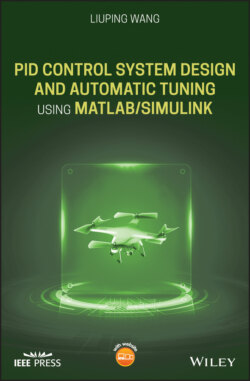Читать книгу PID Control System Design and Automatic Tuning using MATLAB/Simulink - Liuping Wang - Страница 23
Example 1.4
ОглавлениеSuppose that the plant is described by the transfer function:
(1.37)
and the PI part of the controller has the parameters: , Choosing and 1, find the closed-loop transfer function for the PID control system shown in Figure 1.9 and simulate its closed-loop performance. Also, find the closed-loop transfer function of the IPD control system shown in Figure 1.10 and simulate its closed-loop step response.
Solution. The control signal from Figure 1.9 has the Laplace transform given by Equation 1.34. Substituting into the following equation,
(1.38)
re-grouping and re-arranging lead to the closed-loop transfer function:
(1.39)
There are two zeros in the closed-loop transfer function: caused by the integral control, and caused by the derivative control. Figure 1.11(a) shows the closed-loop step responses for and respectively. With the increase in , the oscillation in the closed-loop response is reduced. However, there is a large overshoot in the output response.
Using the IPD structure as shown in Figure 1.10, we calculate the closed-loop transfer function by using the Laplace transform of the controller output given in Equation 1.36. Substituting this control signal into the plant output (see Equation 1.38), the closed-loop transfer function is
(1.40)
Figure 1.11 Step responses of PID control system (Example 1.4). (a) Responses for PID structure. (b) Responses for the IPD structure. Key: line (1) , line (2) (, ).
With this implementation, the denominator of the closed-loop transfer function is the same; however, there is only one zero at caused by the derivative control. Figure 1.11(b) shows the closed-loop step responses with an IPD controller. In comparison with the responses from the previous case, it is seen that the overshoot in the closed-loop responses has been eliminated, however their response speed becomes slower.
